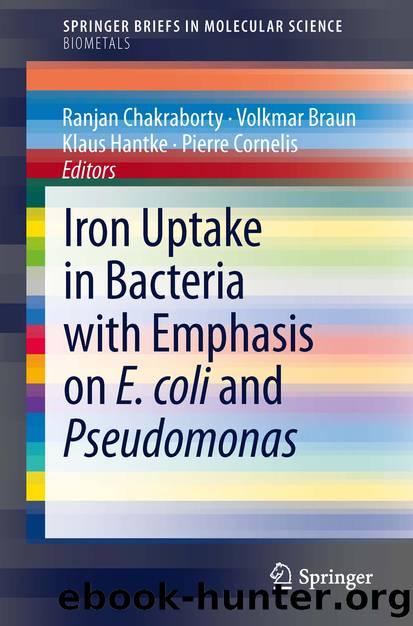Iron Uptake in Bacteria with Emphasis on E. coli and Pseudomonas by Ranjan Chakraborty Volkmar Braun Klaus Hantke & Pierre Cornelis

Author:Ranjan Chakraborty, Volkmar Braun, Klaus Hantke & Pierre Cornelis
Language: eng
Format: epub
Publisher: Springer Netherlands, Dordrecht
2.7 Transport of Fe2+
2.7.1 The Feo System
Under anaerobic/microaerophilic conditions and/or low pH, iron may occur in the Fe2+form, which has a much higher solubility at pH 7 (0.1 M) than Fe3+ (10−18 M). In 1987, an Fe2+ transport system was discovered in E. coli (Hantke 1987) and in the meantime found widely distributed in bacterial genomes (Cartron et al. 2006). The feo operon consists of three genes—feoA, feoB, feoC—arranged in this order and transcribed from a Fe2+-Fur-regulated promoter upstream of feoA. Only FeoB is essential for Fe2+ transport. FeoB is an unusual bacterial transport protein that consists of three domains, an N-terminal GTPase (Marlovits et al. 2003) exposed to the cytoplasm which is linked by a spacer to the C-proximal transmembrane domain. The spacer may function as a GDP dissociation inhibitor (Eng et al. 2008). This kind of structure resembles eukaryotic regulatory GTPases. The crystal structures of the cytosolic domains of Feo from E. coli (Guilfoyle et al. 2009), Methanococcus jannaschii (Köster et al. 2009), and Thermotoga maritima (Hattori et al. 2009) were determined. They elucidate the GTP binding site. The GDP dissociation inhibitor and the GTPase form a large interface with a hydrophobic and two polar interactions. GDP binding to the GTPase domain is stabilized by the interaction of the GTPase with the GDP dissociation inhibitor. It is speculated that this represents the “off state” of the FeoB transporter; the GTP bound state would be the “on state.” Any model must take into account that the GTP hydrolysis rate is much too slow (50 % hydrolysis after 6 h at 37 °C) to serve as an energy source to drive iron import. In contrast, dissociation of GDP is much too fast to regulate the open/closed state. Therefore, additional proteins are most likely involved in FeoB activity regulation, one of which could be FeoA that contains a SH3 domain (Su et al. 2010) which in eukaryotes is involved in protein–protein interactions. It seems that a GTP/GDP cycle regulates the activity of the transporter which resides in the transmembrane portion that makes up most of the protein. No structural or functional studies have been reported on this portion of FeoB. The energy source for Fe2+ transport is another open question. In Helicobacter pylori, ATP hydrolysis has been claimed to drive Fe2+ transport on the experimental basis that FCCP (a protonophore), DCCD (an ATP synthesis inhibitor), and orthovanadate, an ATP hydrolysis inhibitor, abolish high-affinity Fe2+ uptake (Ks = 0.54 μM) (Velayudhan et al. 2000). However, the structure of FeoB does not resemble any ATPase, nor does it contain an ATP but rather a GTP binding motif.
Fe2+ uptake via FeoB is a major pathway for H. pylori Fe acquisition as feoB mutants are unable to colonize the gastric mucosa of mice, which is a low pH, low-oxygen environment. The virulence of other bacteria also depends on the Feo iron transport system. For example, feoB mutants of E. coli show an attenuated ability to colonize the mouse intestine (Stojiljkovic et al. 1993). The LD50
Download
This site does not store any files on its server. We only index and link to content provided by other sites. Please contact the content providers to delete copyright contents if any and email us, we'll remove relevant links or contents immediately.
| Cell Biology | Developmental Biology |
| Entomology | Marine Biology |
| Microbiology | Molecular Biology |
| Biostatistics |
Sapiens: A Brief History of Humankind by Yuval Noah Harari(13054)
The Tidewater Tales by John Barth(12030)
Do No Harm Stories of Life, Death and Brain Surgery by Henry Marsh(6337)
Mastermind: How to Think Like Sherlock Holmes by Maria Konnikova(6236)
The Thirst by Nesbo Jo(5786)
Why We Sleep: Unlocking the Power of Sleep and Dreams by Matthew Walker(5642)
Sapiens by Yuval Noah Harari(4537)
Life 3.0: Being Human in the Age of Artificial Intelligence by Tegmark Max(4509)
The Longevity Diet by Valter Longo(4445)
The Rules Do Not Apply by Ariel Levy(3906)
The Immortal Life of Henrietta Lacks by Rebecca Skloot(3826)
The Body: A Guide for Occupants by Bill Bryson(3802)
Why We Sleep by Matthew Walker(3773)
Animal Frequency by Melissa Alvarez(3755)
Yoga Anatomy by Kaminoff Leslie(3702)
Barron's AP Biology by Goldberg M.S. Deborah T(3632)
The Hacking of the American Mind by Robert H. Lustig(3580)
All Creatures Great and Small by James Herriot(3517)
Yoga Anatomy by Leslie Kaminoff & Amy Matthews(3396)
